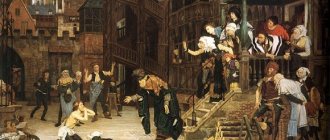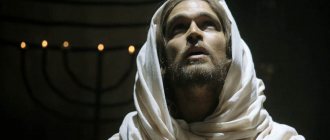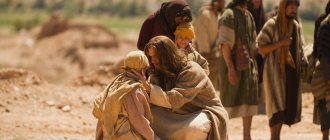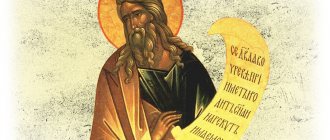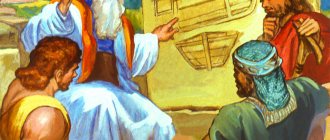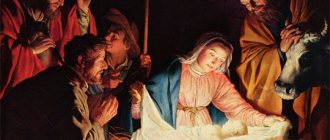The story of the prodigal son in the works of Rembrandt
We find the parable of the prodigal son in the Gospel of Luke. It tells about a young man who left his father's house and squandered his inheritance. He spent his days in idleness, debauchery and drunkenness until he found himself in a barnyard, where he ate from the same trough with the pigs. Finding himself in a desperate situation and complete poverty, the young man returns to his father, ready to become his last slave. But instead of contempt, he finds a royal welcome, instead of anger - all-forgiving, deep and tender fatherly love.
At least three times during his life, Rembrandt turns to the parable of the prodigal son.
1633 “Self-portrait with Saskia”
For the first time, in 1633 in the canvas “Self-portrait with Saskia on her knees”. The painting was painted by Rembrandt during a happy time for him. He had just married the daughter of the burgomaster Saskia van Uylenburch, whom he loved very much. And this was their first and last (except for drawings) joint portrait. The painting shows a smartly dressed girl, young and beautiful. At that time, she behaved rather frivolously, because she was sitting on the lap of a young man who hugged her flexible figure. The young man is a dandy, a carefree dandy in a velvet camisole and a hat with a huge ostrich feather. He is cheerful and pleased with himself: he has the attention of a lady, a glass of sparkling wine in his hands, a hearty dinner is laid on a richly furnished table. Rembrandt depicted himself and his beloved in a carefree pastime, in joy, in ecstasy with life and human happiness.
True, in the upper left corner of the canvas we see a slate board. Such boards usually hung in taverns and the price of what was drunk and eaten was written on them. Was this a hint to the viewer that everything in life will have to be paid for, or simply the composition of the picture required a spot in the corner. Before contemporaries, the picture, in which viewers recognized the young couple, appeared with the title “The Prodigal Son in the Tavern” (“The Feast of the Prodigal Son”). This title conveyed both proud self-irony and the rebellion of the young artist who challenged the prim Dutch burghers. However, he was not understood. The portrait genre was popular among the Amsterdam rich, and Rembrandt’s next painting made him even more famous and expanded his circle of customers.
In 1636, Rembrandt created the etching “The Prodigal Son”. The master’s hand builds the space: he gives a hint of the landscape, depicts minor characters without unnecessary details and focuses all the attention on the two main characters - father and son. In the kneeling figure of the ragamuffin, pressing his cheek to his father's robe, in his face, exhausted by trials and overgrown with hair, in his almost limp hands and convulsively crooked fingers, repentance is visible. And in the father, rushing to his son so that even his shoe flies off his foot and his cane rolls down the steps, in his eyebrows knitted with bitterness, we read only love. True and ardent love of a conveyed heart.
Context
The Return of the Prodigal Son is perhaps Rembrandt's last painting. Work on it was preceded by a series of losses that stretched over 25 years: from the death of his first, beloved wife Saskia and all the children she bore to almost complete ruin and the absence of customers.
The rich clothes in which the heroes are depicted were part of the artist’s collection. In the 17th century, Holland was the strongest economy in the world. The ships of its merchants seemed to be everywhere - there was even trade with Japan (Japan did not trade with anyone else at that time). Outlandish goods flocked to Dutch ports. The artist regularly walked there and bought unusual fabrics, jewelry, and weapons. All this was later used in work. Even for self-portraits, Rembrandt dressed up in foreign clothes and tried on new images.
"Belshazzar's Feast", 1635. (London National Gallery)
In the theatre
They also began to transfer the biblical story to the theater stage back in the Middle Ages; one of the first Russian plays written on the gospel story belongs to Simeon of Polotsk . In the 17th century, he wrote “The Comedy of the Parable of the Prodigal Son,” which almost completely repeats the plot, and a few years later, “The Comedy of Nebuchadnezzar the King,” a dramatic reworking of the same plot.
A striking example of using the plot of a gospel parable is the ballet “The Prodigal Son” by Prokofiev . The greatest cultural figures were involved in the work on the ballet: the idea came to Sergei Diaghilev , the music was written by Sergei Prokofiev, who was living in the West at that time, the performance was staged by George Balanchine , the main role was performed by Sergei Lifar (pictured). “The Prodigal Son” is a masterpiece, the premiere of which was a resounding success, and later the ballet became one of the world’s ballet classics.
In 2012 at the Moscow Drama Theater. Ruben Simonov hosted the premiere of the production “The Prodigal Son (François Villon)”. The plot describes the life story of the medieval poet François Villon , who, having left his father's home at a young age, traveled around the country, carousing, writing poetry and getting into situations that later led to his death.
To the cinema
The film “Solaris” by Andrei Tarkovsky is ambiguous and multi-layered and, despite the generally simple plot, it is extremely difficult to understand the intricacies of the author’s philosophical ideas. And it’s even more difficult for those who read Stanislaw Lem’s . Therefore, it seems impossible to “pick out” and notice the biblical story here the first time. However, it exists, moreover, the entire film seems to be built on its basis - the viewer is convinced of this at the very end, when in the last frame the characters create a composition similar to the above-mentioned work by Rembrandt. And then everything falls into place: space travel, “guests”, return to Earth - all this creates a complete picture.
Donatas Banionis in the film "Solaris". 1972
The theme of the Gospel story about the prodigal son has been used at all times, and each time inspired the creation of masterpieces and rethinking of actions, words and thoughts. It is still relevant now - in pursuit of a career, money, fame, it is very easy to forget about loved ones. These same works, whether paintings, plays or literary works, remind us of the importance of relationships, devotion and respect for others and loved ones.
Greek icon "Return of the Prodigal Son"
The return of the son, who squandered his father's inheritance in the whirlwind of life, is one of the most important and touching parables of Christianity. Some argue that Orthodoxy generally begins with an understanding of the parable of the Prodigal Son, being a kind of litmus test.
The parable tells how two brothers lived in one distant country. One day, the younger brother, who desired freedom and independence, asked the Father for his share of the property, which he was entitled to after the death of the Parent.
His father could not give him anything, because he was still alive, and dividing property while still alive meant agreeing that He was already dead. But the Father does not hold back his son, gives him an inheritance and the son leaves his parental home.
Youth, the desire for happiness, and the riot of blood quickly took their toll - he squandered all his inheritance, remaining alone in a foreign country, without a piece of bread and a roof over his head. In addition, famine began in that distant direction. In order to somehow survive and not die of hunger, he gets a job as a swineherd. It’s hard to think of a more shameful thing for a Jew to do.
The hired worker was fed poorly, and out of necessity he began to eat with the pigs the horns left after their meal. Having lived like this, having suffered from his master and life, he remembered his home, his Father, where even the mercenaries did not live as he did now. And he decided to return to his home.
I. Bosch External doors of the triptych “Hay Wagon”
The decision to return was painful; he wanted nothing more than for the Father to have mercy, forgive him and accept him at least as a simple worker. Dirty, ragged, poor and hungry, he is met on the threshold of his home by the Father, rejoicing at the return of his prodigal son.
The father does not reproach and does not even want to hear about making his son a mercenary. He rejoices that after so many years his son, whom he had already considered dead, returned and turned out to be alive.
The best clothes, the best shoes, the best meal from a fattened calf and forgiveness! Music, joy, fatherly love, native walls again surround the son. He is forgiven and accepted by the Father in mercy and love.
Rembrandt. Return of the Prodigal Son
But was everyone so happy about the return of the fornicator? The eldest son and brother of the prodigal son, having heard the news of the return, in honor of which such a feast and fun had been arranged, became very angry, angry to such an extent that he even refused to enter the house.
His logic was completely different from his father's. And here is the moment of truth. This is where the fork in the road lies—in relation to the return of the fornicator and the great sinner. Everyone can ask, how would he behave in this situation? Not in words, but in reality.
In words, knowing the “correct” answer in the Gospel, as in a textbook, everyone will theoretically answer who he is with. But if you actually happen to be merciful to a sinner, where do complacency and love go?
An old friend of mine still can’t wrap her head around the parable. And today we started discussing it again, and she again doesn’t understand and says that our time is completely different and she is on the side of her older brother-worker.
Return of the Prodigal Son. XIX century.
However, two years ago something happened in church life that divided the Orthodox into lambs and goats. Whoever was on which side is still on the same side: some with sinners, and some with the righteous. And that friend of mine, a churchgoing and faithful parishioner, was also by no means on the side of the fornicator.
In Pharisaic logic, a sinner cannot be forgiven; it never fits into his head that the one who left all his father’s inheritance, which he did not earn, but simply used, in pubs, lost at cards, drank with dubious friends and caroused with girls of easy virtue, is suddenly accepted by the Father so generously, one might say royally.
Greek icon "Return of the Prodigal Son"
And instead of condemnation he meets with forgiveness, instead of punishment with love, instead of gloating (“Yeah, he’s back, he’s had some fun!”) with joy. How so? While he “served” the Father by the sweat of his brow, fulfilling all his orders (here follows a list of merits), this one squandered his father’s wealth.
Resentment, pride, anger overwhelm him: after all, the Father never arranged a feast for him, never invited his friends, never slaughtered, let alone a fattened calf, even a kid! And here - on you! And a feast, and the best clothes, and friends, and singing, and music, and joy.
And in honor of whom!? In honor of the one whom he had long ceased to consider as his brother, the one who wanted to live by his own wits, left home and squandered everything?!
In this regard, the story of Charles Baudelaire comes to mind, who, having received his father’s large inheritance, like a prodigal son, began to spend it on fashionable and rich clothes, expensive cigars, restaurants, drugs, and women.
And how did it end? His birth mother went to court to have guardianship established over Baudelaire in order to avoid waste of the inheritance. The court was on her side. Baudelaire spent his entire life as a beggar, but his mother never gave him back the right to manage his own inheritance. This is what the “righteous” and defenders of the law actually do.
It is not for us to evaluate ourselves whether we are good or bad, for, as the Bible says, what is high among people is an abomination before God. But throughout the entire Gospel there runs the idea of contrasting “the righteous” and sinners, fornicators and Pharisees, who do everything they need to do, but do not know how to love one thing.
Tina Guy
Interesting? Share information!
In literature
Two literary works in the genre of narrative prose were written in the second half of the 17th century - “The Tale of Misfortune” and “The Tale of Savva Gudyn”. Both works refer to the gospel story of the prodigal son. In “Grief-Misfortune,” the main character named Molodets repeats the path of the prodigal son, ending up in the “tsar’s tavern.” In “The Tale of Savva Gudyn,” this plot is combined with a fairy tale, thereby forming an ornate narrative, of which there were no examples in those days.
Alexander Sergeevich Pushkin used a parable to construct the plot of his work . Comparison of his reinterpretation of the Gospel plot and the parable itself is taught in school; this is one of the main topics when “analyzing” the story “The Station Agent”. More precisely, to contrast, because in “The Station Agent” this plot is shown unexpectedly - here it’s the other way around. Instead of the impoverished son-heir, the noblewoman, satisfied with life, comes to the funeral of her impoverished father. Well, the painting “The Return of the Prodigal Son,” hanging on the wall at the beginning of the story, plays the role of the very gun that “fires” at the end of the story.
Pushkin indirectly touches on this topic in his other works - the story “The Captain's Daughter” and the unfinished “Notes of a Young Man”.
Red Mountain in the Orenburg region is a place described in the story “The Captain's Daughter”. Photo: www.russianlook.com
Nikolai Gumilyov's poem “Prodigal Son” is divided into four parts, each of which characterizes one of the hero’s states.
“Father, let me go... tomorrow... today!..” - the desire to leave my father’s house, “Like the edge of the sky is pink behind the portico! How joyful the galleys are in the fiery Tiber!” - ecstasy of freedom, “I’ll go and tell him: “Father, I am a sinner before the Lord and before you” - hardships, adversity and the final decision to return home and, finally, “I found out... guessed... coming to meet me... And the holiday, and this bride... Isn’t it for me?!” It is interesting that Gumilyov’s poem ends without words of forgiveness, and the end is not entirely clear, although everything suggests a happy ending.
In just two quatrains of Ivan Bunin’s “And flowers, and bumblebees, and grass, and ears of corn”, if not the plot, then the moral of the gospel parable is revealed. The Prodigal Son here appears before the Lord, who asks him: “Were you happy in your earthly life?” But there is no answer or ending here either: the son chokes on sweet tears, instead of an answer there is silence.
